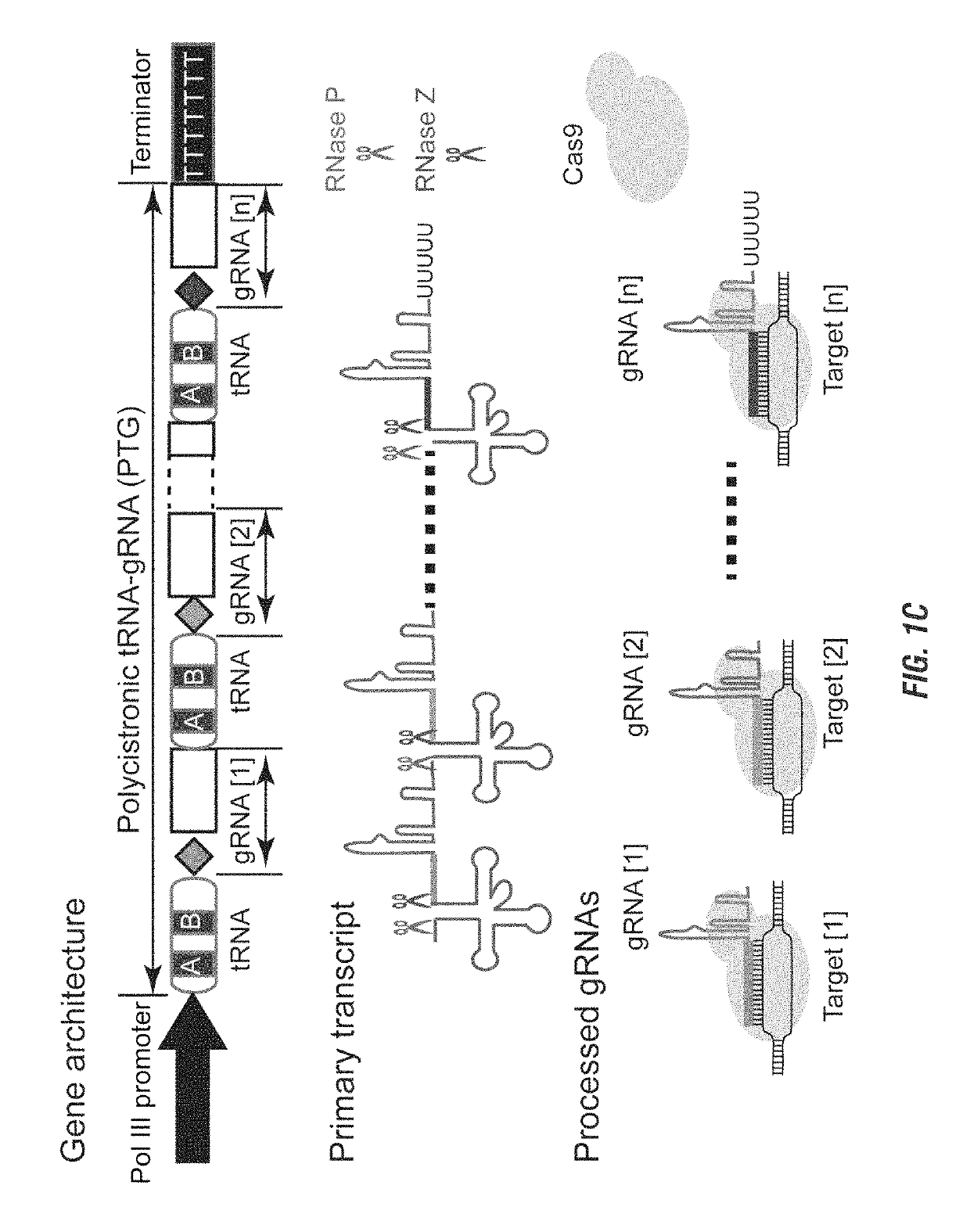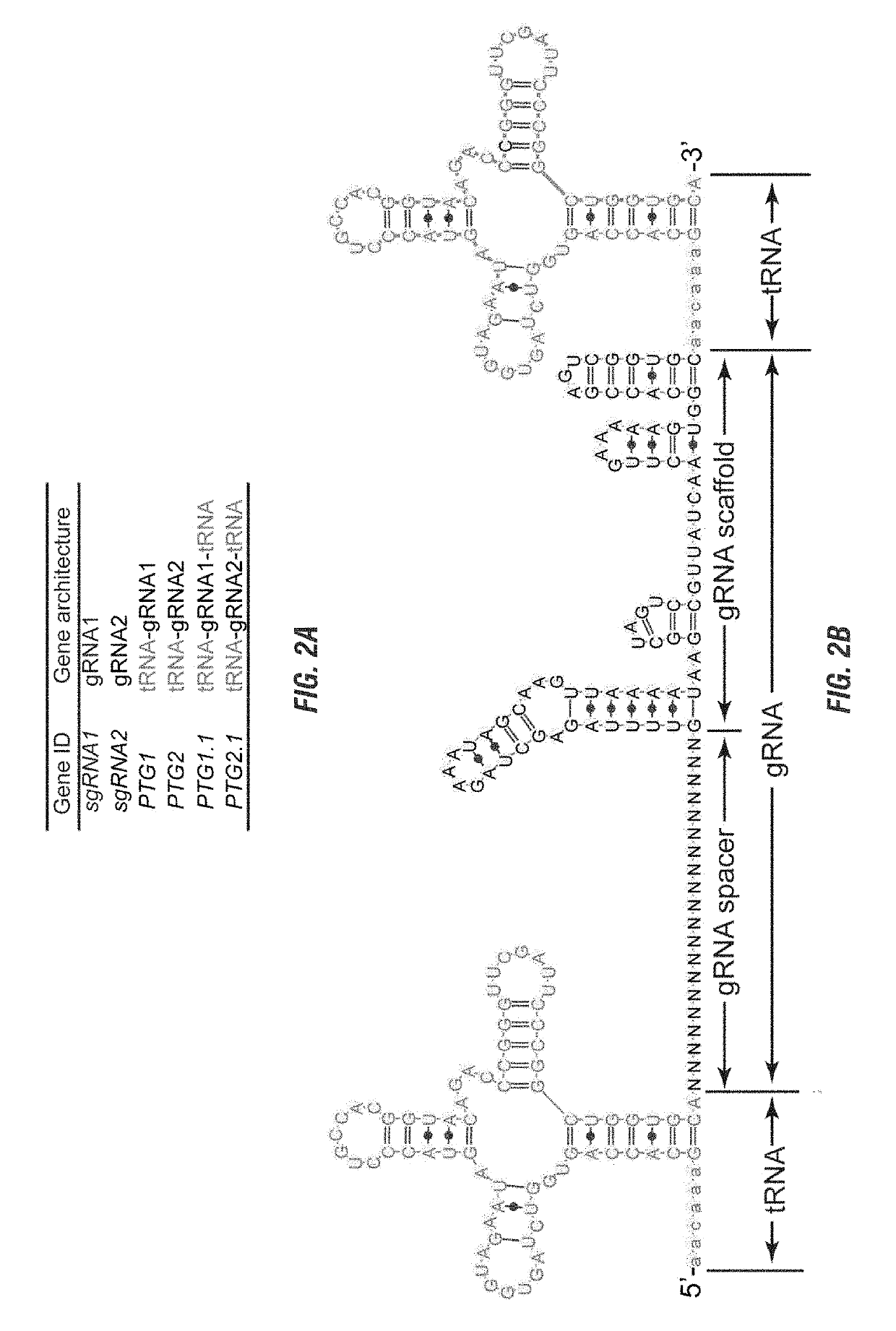Methods and compositions for multiplex RNA guided genome editing and other RNA technologies
a genome editing and genome technology, applied in the field of molecular biology and genetic engineering, can solve the problems of generating simultaneous grnas in plant, animal or microbial organisms, and still a challenge, and achieve the effects of facilitating and reducing the risk of rna-guided multiplex genome editing
- Summary
- Abstract
- Description
- Claims
- Application Information
AI Technical Summary
Benefits of technology
Problems solved by technology
Method used
Image
Examples
example 1
[0137]The CRISPR / Cas9 system is being harnessed as a powerful tool for genome engineering in basic research, molecular therapy and crop improvement. This system utilizes a small guide RNA (gRNA) to direct Cas9 endonuclease to a specific DNA site, thus its targeting capability is largely constrained by the gRNA expressing device. Applicants developed a general strategy to produce numerous gRNAs from a single polycistronic gene. The endogenous tRNA processing system, which precisely cleaves both ends of the tRNA precursor, was engineered as a simple and robust platform to boost the targeting and multiplex editing capability of the CRISPR / Cas9 system. Applicants herein demonstrate that synthetic genes with tandemly arrayed tRNA-gRNA architecture were efficiently and precisely processed into gRNAs with desired 5′ targeting sequences in vivo, which directed Cas9 to edit multiple chromosomal targets. Using this strategy, multiplex genome editing and chromosomal fragment deletion were read...
example 2
Supporting Information
Plasmid Vector Construction
[0202]To construct pRGE32, the rice UBIp fragment was amplified from genomic DNA of Nipponbare cultivar with a pair of specific primers (UBI-F and UBI-R, see Table S2 for primer sequences). After amplifying the U3p-gRNA fragment from pRGE31 (Addgene plasmid 50929) with primers UGW-U3-F and UGW-gRNA-R, the U3p-gRNA and UBIp fragments were linked together by overlapping extension PCR with primers UGW-U3-F and UBI-R. Then pRGE32 was constructed by Gibson Cloning (New England Biolabs) to replace the U3p-gRNA-35S fragment in pRGE31 with U3p-gRN4-UBIp. The pRGEB32 binary vector (see FIG. 6 for vector map) used for the Agrobacterium-mediated rice transformation was created by inserting the U3p-gRNA-UBIp-Cas9 fragment from pRGE32 into pCAMBIA1301-BsaI with Gibson Cloning (New England Biolabs). The pCAMBIA1300-BsaI is derived from pCAMBIA1300 after removing all of BsaI sites through site-directed mutagenesis. The primers used in plasmid constr...
example 3
Polycistronic tRNA and CRISPR Guide-RNA Enables Highly Efficient Multiplexed Genome Engineering in Human Cells
[0264]During the past three years, the clustered regularly interspaced short palindromic repeat (CRISPR) and CRISPR-associated protein nuclease has emerged as the most powerful tool for genome editing in many organisms (1-4). The most commonly used Cas endonuclease for genome editing is Streptococcus pyogenes Cas9 (referred as Cas9 hereafter). The Cas9 protein is guided by an artificial short guide RNA (gRNA) to cleave the DNA whose sequence is complement to the 5′-end of gRNA and preceded with the protospacer-adjacent motif (PAM, 5′-NGG-3′) (5-7). This simple RNA guided DNA targeting system fundamentally enhanced our ability to access specific genomic sites for genetic manipulation. The CRISPR-Cas9 system has been engineered for targeted mutagenesis, site-specific integration of DNA fragment, and precise manipulation of chromosomes such as large segment deletion and translo...
PUM
| Property | Measurement | Unit |
|---|---|---|
| pH | aaaaa | aaaaa |
| volume | aaaaa | aaaaa |
| temperature | aaaaa | aaaaa |
Abstract
Description
Claims
Application Information
 Login to View More
Login to View More - R&D
- Intellectual Property
- Life Sciences
- Materials
- Tech Scout
- Unparalleled Data Quality
- Higher Quality Content
- 60% Fewer Hallucinations
Browse by: Latest US Patents, China's latest patents, Technical Efficacy Thesaurus, Application Domain, Technology Topic, Popular Technical Reports.
© 2025 PatSnap. All rights reserved.Legal|Privacy policy|Modern Slavery Act Transparency Statement|Sitemap|About US| Contact US: help@patsnap.com



